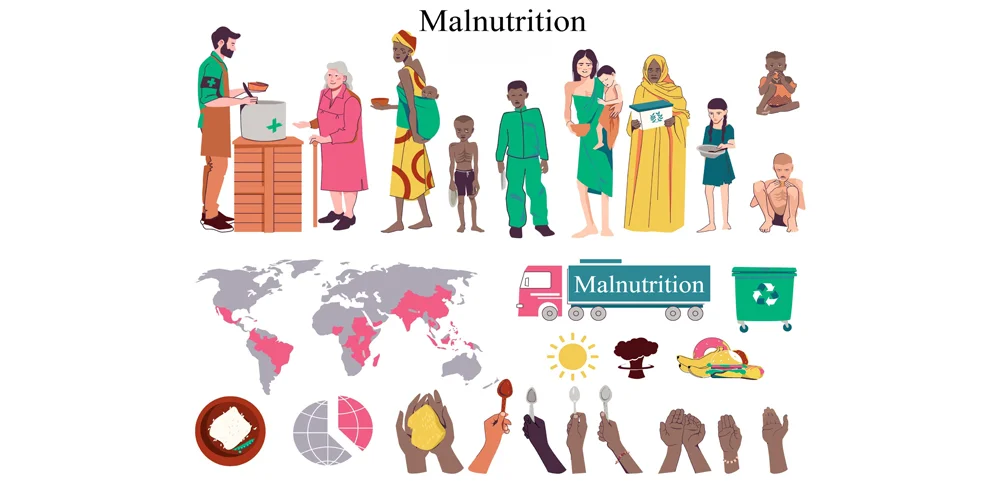Malnutrition: Types, Symptoms, Causes & Remedies, is a condition that occurs when an individual’s diet does not provide the essential nutrients, vitamins, and minerals needed for the proper growth, development, and maintenance of their overall health. It can manifest in various forms, including undernutrition, overnutrition, or specific nutrient deficiencies.
Types of Malnutrition
Malnutrition can manifest in various forms, and the specific types of malnutrition include:
- Protein-Energy Malnutrition (PEM):
– Kwashiorkor: Kwashiorkor is a form of severe acute malnutrition characterized by a lack of protein intake despite sufficient calorie intake. It often leads to symptoms such as edema (swelling), skin and hair changes, and muscle wasting.
– Marasmus: Marasmus is another form of severe acute malnutrition but is characterized by a deficiency in both calories and protein. It leads to severe emaciation, muscle and fat loss, and overall wasting of the body. - Micronutrient Malnutrition:
– Micronutrient malnutrition, also known as hidden hunger, occurs when there is a deficiency in essential vitamins and minerals. Common micronutrient deficiencies include iron deficiency anemia, vitamin A deficiency, iodine deficiency disorders, and folate deficiency. - Overnutrition:
– Overnutrition refers to the excessive intake of calories and nutrients, often resulting in obesity and associated health problems such as type 2 diabetes, cardiovascular diseases, and metabolic disorders. - Specific Nutrient Deficiencies:
– Specific nutrient deficiencies can occur when there is an insufficient intake of a particular vitamin or mineral. Common examples include vitamin D deficiency, vitamin C deficiency (scurvy), vitamin B12 deficiency (pernicious anemia), and iron deficiency. - Wasting and Stunting:
– Wasting is a condition where there is a significant loss of muscle and fat mass, leading to a low weight-for-height ratio. Stunting, on the other hand, is characterized by impaired growth and low height-for-age. Both wasting and stunting are indicators of chronic malnutrition and are common in children. - Obesity-Related Malnutrition:
– Obesity, while often associated with overnutrition, can paradoxically coexist with nutrient deficiencies, as individuals may consume high-calorie, low-nutrient foods, leading to an imbalance in nutrient intake. - Underweight and Overweight:
– Malnutrition can also be categorized based on an individual’s body mass index (BMI). Those with a BMI below the healthy range are considered underweight, while those with a BMI above the healthy range are considered overweight or obese.
These various forms of malnutrition can have serious health consequences and may require different approaches for prevention and treatment. Addressing malnutrition often involves improving dietary habits, food security, and access to essential nutrients, as well as addressing underlying social and economic factors that contribute to the condition.

Symptoms of Malnutrition
The symptoms of malnutrition can vary depending on the type and severity of the malnutrition.
Common symptoms of malnutrition include:
- Weight Loss: A noticeable and unintended reduction in body weight is a common sign of malnutrition, particularly in cases of undernutrition.
- Fatigue and Weakness: Malnourished individuals may experience constant fatigue, weakness, and a lack of energy to carry out daily activities.
- Muscle Wasting: Severe malnutrition can lead to muscle wasting, causing a loss of muscle mass and strength.
- Edema: In cases of kwashiorkor, which is a form of protein-energy malnutrition, individuals may develop edema, which is the abnormal accumulation of fluid in the tissues, leading to swelling, particularly in the legs and feet.
- Poor Growth: Malnutrition in children can result in poor growth, leading to stunted height and delayed physical and cognitive development.
- Skin Problems: Skin changes are common in malnourished individuals. They may experience dry and flaky skin, rashes, and lesions.
- Hair and Nail Changes: Malnutrition can cause hair thinning or loss, as well as brittle nails that are prone to breaking.
- Anemia: A deficiency in iron, vitamin B12, or folate can lead to anemia, characterized by fatigue, paleness, and shortness of breath.
- Weakened Immune System: Malnutrition compromises the immune system, making individuals more susceptible to infections and illnesses.
- Difficulty Concentrating: Malnourished individuals may have difficulty concentrating, memory problems, and cognitive impairment.
- Gastrointestinal Issues: Malnutrition can cause gastrointestinal problems such as diarrhea, constipation, or difficulty swallowing.
- Dental Issues: Nutrient deficiencies, particularly in vitamin D and calcium, can lead to dental problems, including tooth decay and gum disease.
- Swallowing Difficulties: Malnutrition can weaken the muscles involved in swallowing, leading to dysphagia (difficulty swallowing).
- Cardiac Problems: Severe malnutrition may result in cardiac issues, including arrhythmias and heart failure.
- Behavioral Changes: Malnutrition can affect mood and behavior, leading to irritability, depression, and anxiety.
It’s important to note that the symptoms of malnutrition can be subtle or severe, and they may vary based on the specific nutrient deficiencies and the duration of malnutrition. The severity of symptoms often correlates with the extent of malnutrition. If you suspect malnutrition in yourself or someone else, it’s essential to seek medical attention to address the underlying causes and provide appropriate treatment and nutritional support.
Causes of Malnutrition
Malnutrition can have various causes, and it often results from a complex interplay of factors.
The causes of malnutrition can be broadly categorized into the following:
- Inadequate Diet:
– Insufficient intake of calories, protein, and essential nutrients in the diet is a primary cause of malnutrition. This can result from poverty, food insecurity, or limited access to nutritious foods. - Poor Nutrient Absorption:
– Malabsorption disorders, such as celiac disease, Crohn’s disease, and certain gastrointestinal conditions, can hinder the body’s ability to absorb nutrients from the food consumed, even when the diet is adequate. - Infections and Diseases:
– Chronic infections, such as HIV/AIDS, tuberculosis, and parasitic diseases, can increase the body’s nutrient requirements and impair its ability to absorb and utilize nutrients, contributing to malnutrition. - Lack of Access to Clean Water and Sanitation:
– Inadequate access to clean drinking water and proper sanitation can lead to waterborne diseases, diarrhea, and other illnesses that increase nutrient loss and decrease appetite, leading to malnutrition. - Poverty and Food Insecurity:
– Economic factors, such as poverty and lack of resources, can restrict access to sufficient and nutritious food. Inadequate financial means can lead to reliance on low-quality, calorie-dense foods. - Social and Cultural Factors:
– Social and cultural practices, including dietary restrictions, taboos, and food preferences, can limit food choices and lead to nutritional imbalances. - Lack of Education:
– Lack of knowledge about proper nutrition, especially during pregnancy and early childhood, can result in poor dietary choices and practices. - Political and Environmental Factors:
– Conflicts, displacement, and environmental factors, such as droughts or natural disasters, can disrupt food production and distribution systems, leading to food shortages and malnutrition. - Substance Abuse:
– Substance abuse, including alcohol and drug addiction, can lead to poor dietary choices and neglect of nutritional needs. - Eating Disorders:
– Conditions like anorexia nervosa and bulimia nervosa can result in severe malnutrition due to restricted food intake or purging behaviors. - Aging:
– The elderly are more susceptible to malnutrition due to reduced appetite, difficulties with food preparation and chewing, and chronic health conditions. - Lack of Breastfeeding:
– In infants, lack of breastfeeding or inappropriate feeding practices can lead to malnutrition. Breast milk is the ideal source of nutrition for infants during the first six months of life. - Specific Nutrient Deficiencies:
– Some individuals may develop malnutrition due to a deficiency of a specific nutrient, such as iron, vitamin D, vitamin B12, or iodine, often related to dietary choices and health conditions.
Addressing malnutrition requires a multifaceted approach that includes improving access to nutritious food, enhancing healthcare, education, and social support systems, and addressing the underlying factors contributing to malnutrition. This may involve government policies, healthcare interventions, community-based programs, and individual dietary and lifestyle changes.
Remedies of Malnutrition
Remedying malnutrition typically involves a combination of nutritional, medical, and social interventions. The specific remedies for malnutrition can vary depending on the underlying causes and the severity of the condition.
Here are some common approaches to address malnutrition:
- Nutritional Rehabilitation:
– Providing a balanced and nutrient-rich diet is essential for treating malnutrition. This may involve dietary changes and supplementation with essential vitamins and minerals. In severe cases, therapeutic feeding programs using specialized therapeutic foods may be necessary. - Medical Treatment:
– In cases of malnutrition due to underlying medical conditions or infections, medical treatment is crucial. This can include the management of infections, treatment of digestive disorders, and addressing malabsorption issues. - Supportive Care:
– Providing supportive care and addressing complications such as dehydration, electrolyte imbalances, and anemia is vital in severe cases of malnutrition. - Hydration:
– Ensuring proper hydration is essential. In some cases, oral rehydration solutions may be needed to address fluid and electrolyte imbalances. - Nutritional Counseling:
– Nutritional education and counseling can help individuals and families make informed choices about their diets and develop better eating habits. - Supplementary Feeding Programs:
– Government and non-governmental organizations often implement supplementary feeding programs for malnourished individuals, particularly children, to ensure they receive adequate nutrition. - Breastfeeding Promotion:
– Encouraging and supporting breastfeeding, especially in infants and young children, is crucial to prevent and treat malnutrition. - Fortification:
– Food fortification programs, where essential nutrients are added to staple foods, can help address nutrient deficiencies in populations. - Food Security:
– Improving access to affordable, nutritious foods and addressing issues related to food security, such as poverty and availability of food, can help prevent malnutrition. - Public Health Interventions:
– Government policies and programs aimed at improving healthcare, sanitation, and access to clean water can have a significant impact on reducing malnutrition. - Social Support:
– Providing social support and addressing underlying social and economic factors contributing to malnutrition, such as poverty, can be crucial in the treatment and prevention of malnutrition. - Education and Awareness:
– Raising awareness about the importance of nutrition, proper food preparation, and the risks associated with malnutrition can help prevent the condition. - Regular Monitoring:
– Regular monitoring of nutritional status and growth in children, especially during the early years of life, is important to identify and address malnutrition at an early stage.
The specific remedies for malnutrition should be tailored to the individual’s needs, and healthcare professionals play a crucial role in diagnosing and managing malnutrition. It is important to seek medical advice and professional guidance when addressing malnutrition, especially in cases of severe or prolonged malnutrition, as it may require specialized medical and nutritional care.

What are tips to avoid malnutrition?
Preventing malnutrition involves making informed dietary choices, ensuring access to nutritious foods, and adopting healthy eating habits.
Here are some tips to help avoid malnutrition:
- Eat a Balanced Diet:
– Consume a variety of foods from different food groups, including fruits, vegetables, whole grains, lean proteins, and dairy or dairy alternatives. This helps ensure a wide range of essential nutrients in your diet. - Maintain a Healthy Weight:
– Maintain a healthy body weight through a balanced diet and regular physical activity. Avoid excessive weight loss or gain, as both can contribute to malnutrition. - Portion Control:
– Pay attention to portion sizes to avoid overeating or undereating. Eating appropriate portion sizes helps ensure you get the right amount of nutrients. - Choose Nutrient-Rich Foods:
– Prioritize foods that are nutrient-dense, meaning they provide a high amount of essential nutrients relative to their calorie content. Examples include leafy greens, lean proteins, and whole grains. - Stay Hydrated:
– Drink an adequate amount of water throughout the day. Dehydration can affect nutrient absorption and overall health. - Avoid Excessive Sugar and Processed Foods:
– Limit the consumption of sugary beverages, processed foods, and foods high in added sugars. These foods can displace more nutritious options and lead to empty calorie intake. - Reduce Salt Intake:
– Consume less sodium by limiting the intake of highly processed and salty foods. High sodium intake can lead to health problems. - Moderate Alcohol Consumption:
– If you drink alcohol, do so in moderation. Excessive alcohol consumption can interfere with nutrient absorption and metabolism. - Breastfeed Infants:
– If you are a new mother, consider breastfeeding your infant exclusively for the first six months of life. Breast milk provides essential nutrients for the baby’s growth and development. - Promote Healthy Eating in Children:
– Encourage healthy eating habits in children from a young age. Provide them with a variety of nutritious foods and set a positive example through your own eating habits. - Seek Nutritional Guidance:
– If you have specific dietary concerns or health conditions, consult with a registered dietitian or healthcare professional for personalized nutrition guidance. - Address Food Allergies and Intolerances:
– If you have food allergies or intolerances, make sure to avoid triggering foods and seek alternative sources of necessary nutrients to avoid deficiencies. - Practice Safe Food Handling:
– Ensure proper food hygiene, including safe storage, cooking, and handling of food, to prevent foodborne illnesses that can affect nutrient absorption. - Monitor Nutrient Intake:
– Keep track of your nutrient intake by reading food labels, especially for essential vitamins and minerals. Consider supplements if you have specific deficiencies. - Regular Health Check-Ups:
– Visit your healthcare provider regularly for health check-ups and screenings to detect and address any underlying health issues that may affect your nutritional status. - Maintain Mental Health:
– Address stress, anxiety, and depression, as mental health issues can influence eating habits and nutrient intake.
Remember that individual nutritional needs vary, and it’s essential to adapt your diet to your age, gender, activity level, and specific health conditions. A well-balanced and varied diet, along with a healthy lifestyle, plays a crucial role in preventing malnutrition and promoting overall well-being.
What food is best for malnutrition?
The choice of foods for addressing malnutrition should focus on providing a balanced intake of essential nutrients.
Here are some nutritious foods that are often recommended for individuals with malnutrition:
- Protein-Rich Foods:
– Lean meats, poultry, fish, and eggs: These are excellent sources of high-quality protein, essential for tissue repair and muscle maintenance.
– Legumes (e.g., lentils, beans, and peas): Rich in both protein and fiber, legumes are nutritious and can help meet protein needs.
– Dairy or dairy alternatives: Milk, yogurt, and fortified plant-based alternatives provide protein, calcium, and other important nutrients. - Whole Grains:
– Whole grains such as brown rice, quinoa, whole wheat bread, and oats are rich in carbohydrates and fiber, providing energy and promoting digestive health. - Fruits and Vegetables:
– A variety of colorful fruits and vegetables provide essential vitamins, minerals, and antioxidants. Choose fresh, frozen, or canned (with no added sugar or salt) options. - Nuts and Seeds:
– Almonds, walnuts, chia seeds, and flaxseeds are nutrient-dense sources of healthy fats, protein, and essential vitamins and minerals. - Dairy or Plant-Based Milk:
– Milk, yogurt, and fortified plant-based milks (e.g., almond, soy, or oat milk) provide calcium, vitamin D, and protein. - Nutrient-Dense Foods:
– Eggs: Eggs are a good source of high-quality protein, vitamins, and minerals.
– Sweet potatoes: They are rich in vitamins A and C, as well as dietary fiber.
– Spinach and other leafy greens: These are packed with vitamins, minerals, and fiber.
– Fortified cereals: Choose cereals that are fortified with essential vitamins and minerals, such as iron and B vitamins. - Nutrient-Rich Soups and Broths:
– Homemade or low-sodium broths and soups can provide a combination of nutrients and fluids. - Hydration:
– Clean water, herbal teas, and other hydrating beverages are essential for overall health and hydration. - Nutrient Supplements:
– In severe cases of malnutrition or specific nutrient deficiencies, healthcare professionals may prescribe nutritional supplements or therapeutic foods.
It’s essential to adapt the diet to the individual’s specific nutritional needs, age, and any underlying health conditions. Consulting with a registered dietitian or healthcare provider can help develop a personalized nutrition plan to address malnutrition effectively. Additionally, gradual reintroduction of foods may be necessary for individuals who have experienced prolonged malnutrition to prevent refeeding syndrome, a potentially life-threatening condition that can occur when malnourished individuals start eating normally.
Foodborne Diseases: Types, Symptoms, Causes & Prevention
Irritable Bowel Syndrome: Types, Symptoms, Causes & Prevention
Breast Cancer: Types, Symptoms, Causes, & Prevention
Migraine: Types, Symptoms, Causes & Home Remedies
Understanding Syncope: Symptoms, Causes & Home Remedies
Freckle: Symptoms, Causes, Prevention & Need to Know





